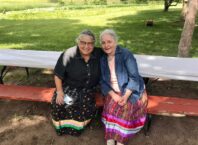Nonprofit organizations that deliver social services to Native Americans in Minnesota still struggle to quantify economic conditions for the Native population. They grapple for ways to measure social successes in economic terms and, at the same time, appeal for resources that haven’t fully recovered from the Great Recession of 2008-2009.
It’s not that money from foundations and government programs are just now catching up, said Joe Hobot, president and chief executive officer at American Indian OIC (AIOIC) in Minneapolis. Information on current conditions for the Native population is lacking when compared to other racial and ethnic groups, he said.
Grant programs from government agencies and the philanthropic foundations were changed over the past eight years, often from mission-driven to program-driven goals that need measurement, he said. While measured outcomes can justify support for the programs, it can also make finding support to cover overhead expenses more difficult.
“We can’t show jobs gained from training programs in one year when you are helping unemployed people with third grade math and fourth grade reading skills,” he said. We don’t have a way to show progress from our ‘wrap-around’ services that get people into the workforce.”
Meanwhile, U.S. Census Bureau and state monitoring agencies come up short in actually tracking data on Native American unemployment, joblessness, household incomes, and even identifying who is a Native American.
By extrapolating data that is available, however, Hobot said it appears one in two American Indians living in Minnesota are “jobless.” That combines people who are officially listed as unemployed with those who aren’t considered to be part of the workforce.
Patina Park, executive director of the Minnesota Indian Women’s Resource Center in Minneapolis, said funding support for her social service programs are now just getting back to pre-Great Recession levels. That recovery is fueled by federal funds, she said, and not by more local sources of financial support.
The Federal Reserve Bank of Minneapolis reported in April 2015 that foundational assets in general had recovered to pre-2008 levels. In its Fedgazette magazine, the Fed noted the recovery was uneven for groups and geographies. The lingering economic disparity from the recession had created more need for services even as funding support dwindled.
The Fedgazette article, All In The (nNonprofit) Family, quoted Katie Barr of the Nonprofits Assistance Fund in Minneapolis in saying service delivery models in the social services sector are labor intensive so program and productivity efficiency gains over time are small.
This is the reality facing Hobot, Park, and at least 20 other social services providers for the Native American communities in the Twin Cities and statewide.
“We’ve been helped by some federal grants,” Park said. “That brings us back to about where we were before the recession.” At the same time, she added, foundations that support social service programs are slowly recovering their own budgets. Local government support, especially from counties, still lags where government budgets reflect problems from the housing market’s collapse and its spillover on property taxes, she added.
While economists and political scientists would predict a lag time for recovery from something as severe as the Great Recession, the impact on communities in need is predictably greater than for a state’s general population. It also contributes to the income inequality that continues to divide the state and nation.
Park joined Hobot in presenting brief testimony in January at a Legislative Working Group on Disparities and Opportunities hearing in St. Paul. The Working Group and other governmental responses are largely the result of the Census Bureau and its ongoing American Community Survey tabulations that follow demographic and economic data for various American ethnic communities.
“More vocal groups brought greater awareness to their communities’ disparities,” Hobot said. For instance, cities, counties and state institutions such as the Minnesota Department of Employment and Economic Development (DEED) all became alarmed when last September’s ACS report showed household incomes for African Americans in Minnesota declined by 3 percent from 2013 to 2014.
Native American service organizations, however, are still searching for ways to read, analyze and advocate based on available data and on what statistical information is still missing.
As February came to an end, executive directors of 20 American Indian nonprofit service providers (501c3 organizations) were drafting a letter to Gov. Mark Dayton and to state DEED officials calling for more data gathering and for more collaboration on programs. That joint letter from directors of the Metropolitan Urban Indian Directors (MUID) was to be sent to state officials in early March.
From available data, MUID affiliated organizations and AIOIC have concluded that Native American households in Minnesota have an annual median income of $32,000, or 48 percent less than the state’s median household income of $61,500. The unemployment rate for American Indians was 10.8 percent at year’s end, while it was 3.7 percent statewide. Government measurements also considered 40.8 percent of working age American Indians in the state as “not in the labor force.”
Hobot said this latter category is especially troubling in that there are no good definitions or data on why this is so. In some cases, he said, there are wealthy people who aren’t looking for employment. For far too many, however, it means long-time unemployed have given up looking and therefore aren’t counted as being part of the potential workforce.
Combine the data, “and we can say that one in two, or 52 percent of working age American Indians, are jobless in Minnesota,” he said.
While they work with DEED and government agencies to make American Indian data more visible and understandable, service provider groups are taking steps to make their own programs more efficient, less duplicative, and better at information and service sharing.
AIOIC, Park’s women’s group, United Tribes of Little Earth and the Minneapolis American Indian Center, all of Minneapolis; and the Northwest Indian Community Development Center at Bemidji are currently forming a new referral and collaborative entity labeled the Indigenous Organizational Network, or ION.
All participating organizations have training programs that help the jobless return to the workforce. All have so-called wrap-around programs that are culturally sensitive to help American Indians prepare for meaningful jobs and careers.
On top of that, more collaboration among groups will lead to more information sharing so “the indigenous population won’t be such an invisible group,” Hobot said.






